Peer-reviewed publications by Texas A&M AgriLife and Texas A&M University System scientists
This research, coauthored by Texas A&M AgriLife Research scientists, investigated the long-term effects of conventional tillage and no tillage in combination with various amounts of cover crops on rye and mixed crops over 30 years. They determined that long term, the use of no tillage and cover crops could improve soil water, total nitrogen and soil organic carbon.
Grass Clippings Mulching Improves Infiltrability of Low-Permeability Dryland Soils:
In this study, coauthored by a Texas A&M AgriLife professor, researchers tested the effect of grass clipping mulching on the infiltrability of dryland soils. They found that grass clippings increased infiltrability, indicating their potential as a low-cost and environmentally friendly way to improve the use of dryland soil.
Led by researchers from Texas A&M University’s Zachry Department of Civil and Environmental Engineering, this study introduces a new algorithm to map reservoir water surface areas. This algorithm was developed to monitor changes more frequently than previous methods and to address common challenges. They found the measurements from this algorithm closely matched in situ measurements, making it useful for water resource management and flood control.
Analysis of the impact of ambient groundwater flow on the aquifer thermal energy storage systems
In this study, researchers from Texas A&M constructed numerical models to determine the impact of ambient groundwater flow (AGF) on aquifer thermal energy storage systems. They found that the recovery efficiency is negatively affected by AGF and identified at what point the effect of AGF is negligible.
Researchers from the Texas A&M AgriLife Center at Lubbock and Texas Tech University investigated the interactive effects of deficit irrigation and biochar amendment on cucumbers. They found that in water-limited West Texas, deficit irrigation levels that maintain moderate water stress conditions can be an effective strategy, but biochar application had limited benefits.
In this study, Texas A&M AgriLife Lubbock Center and Texas Tech University researchers investigated the effects of biochar application and growth stage-based irrigation management on sweet corn. They found that moderate water stress levels can sustain crops and save 25% of water, but biochar had little impact. These findings have important implications for agricultural production as water availability declines in West Texas.
This research from Texas A&M AgriLife and Texas A&M researchers aimed to improve the use of the North American Multi-Model Ensemble (NMME) for crop modeling and irrigation decision-making. They found that using a downscaling method improved the reliability of NMME data used for crop modeling and irrigation decision-making.
Recent research from other Texas universities
Unveiling four decades of spatiotemporal climate trends in Texas (1981–2023):
University of Texas at Dallas and Texas Tech researchers investigated climate trends from 1981 to 2023, specifically focusing on temperature, precipitation, and specific humidity. They found distinct spatial and seasonal patterns, but no annual or monthly trends. The authors say the results indicate a growing climate divide between humid and arid regions that warrant adjustments to agricultural production.
This study, by researchers from Texas Tech’s Department of Plant and Soil Science, presents a deep learning framework to map sorghum, cotton, and maize fields. It also proposes a remote sensing method to track irrigation sources and groundwater use, and projects that groundwater will decline 2m annually through 2030. These systems could be useful to address groundwater depletion, especially in the Texas High Plains.
Researchers from the University of Texas at Austin’s Center for Water and the Environment developed river-floodplain models based on the lower Trinity River in Texas. One key finding is that during small floods, secondary channels control flood peak attenuation whereas floodplain width controls during larger floods. This study is important for understanding flooding dynamics under various hydrologic and topographic conditions.


